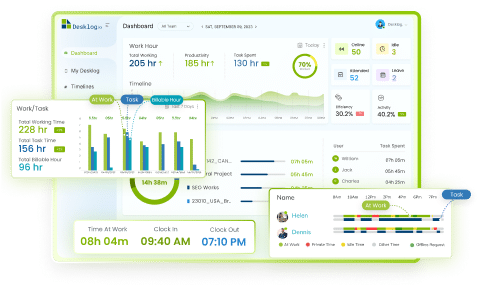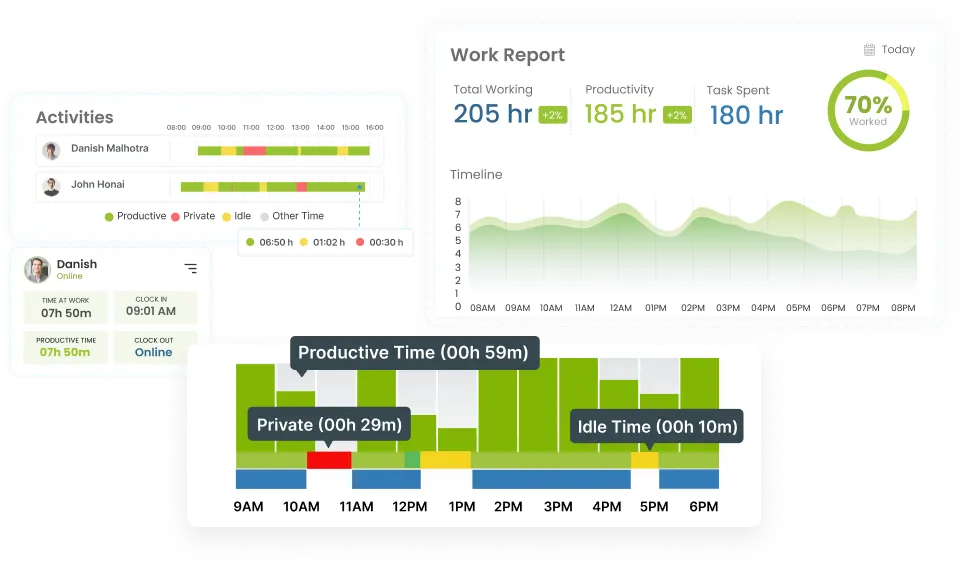In simple words, paid time off (PTO) is getting paid to take a break from work! Instead of having separate days for vacation, being sick, or personal stuff, some companies just give you a bunch of hours to use however you need.
Many companies offer paid time off (PTO) instead of separate vacation days, sick days, and personal days. It’s like a big bucket of time off you can use for whatever you need.
PTO keeps things flexible and helps you avoid juggling different types of leave. Plus, it’s a perk that lets you recharge and come back to work feeling refreshed and ready to take on anything!
Managing PTO efficiently can be streamlined with the help of leave management software. Time tracking softwares helps in staying productive.These tools help both employees and employers manage employee attendance and track leave balances effortlessly, ensuring that the process is smooth and transparent for everyone involved.
What is PTO?
Paid Time Off (PTO) is a program provided by many companies that allows employees to take a specified number of days off while still receiving compensation. This typically covers absences for vacation, illness, and personal reasons.
Key differences between Paid Time Off (PTO) and unpaid leave :
Paid Time Off and unpaid leave are both ways to take time off work, but there’s a key difference: pay.
PTO (Paid Time Off): When you take a vacation, get sick, or need a personal day, you use these hours and still get paid your regular salary.
Unpaid Leave: This is exactly what it sounds like – time away from work that isn’t compensated. While some companies allow unpaid leave for emergencies or extended absences, you won’t be getting a paycheck for that time.
Here’s how PTO benefits both employers and employees
For Employees
Financial Security: With PTO, you don’t have to choose between taking a break and getting paid. This helps you relax and recharge without worrying about bills piling up.
Flexibility: PTO lets you use your time off for whatever you need, whether it’s a planned vacation, a sudden illness, or a personal matter.
For Employers
Happier Employees: When employees feel valued and get time to rest and recharge, they tend to be happier and more productive when they’re back at work.
Lower Turnover: Competitive PTO programs can help attract and retain top talent, saving companies money on recruiting and training new employees.
So, while both PTO and unpaid leave allow for time off, PTO offers the clear advantage of getting paid while you relax and recharge.
Is Personal Time Off the Same As Paid Time Off?
No, they aren’t the same even though they are very close and similar to each other.
Paid Time Off (PTO) is a time off work that your employer gives you. It covers all the different reasons you might need a break and still get paid.
Crucially, all personal time off qualifies as Paid Time Off , but not all PTO falls under the category of personal time off. PTO offers a wider range of options for leave, while personal time off represents a more specific type of absence.
Different ways PTO can be accrued
Front-loading: Some companies grant the entire yearly PTO allowance at the beginning of the year (or on your anniversary date).
Accrual Throughout the Year: This is more common. Employees earn PTO hours over time, typically with each paycheck or pay period.
Factors Affecting Accrual Rates:
Length of Service: Many companies reward loyalty! Employees might start with a lower amount of paid time off or PTO and see it increase the longer you’re with the company.
Company Policy: Every company sets its own rules for PTO accrual. This can depend on factors like industry, company size, and overall benefits package.
PTO can be broken down into different categories depending on the company’s policy. Here’s a breakdown of the most common types:
Sick Leave:
Sick leave is an essential provision that allows employees to take time off work to recover from illness or attend medical appointments without the fear of losing income. This type of leave acknowledges that maintaining health is paramount and that employees should not have to choose between their well-being and their job security.
Sick leave can cover a range of situations, from short-term illnesses like the flu to more extended periods required for recovery from surgery or managing chronic conditions. Some organizations offer paid sick leave, while others may provide unpaid leave, but the key is that it offers a safety net for employees during times of health-related challenges.
Vacation days
Vacation time is a crucial component of work-life balance, allowing employees to step away from their professional responsibilities and recharge. This time can be used for a variety of activities such as traveling to new destinations, spending quality time with family and friends, or simply relaxing at home.
The main objective of vacation time is to provide employees with a break from their daily work routine, helping to reduce stress, increase job satisfaction, and improve overall well-being. Organizations often have specific policies regarding the accrual and usage of vacation days, ensuring that employees have the opportunity to take this much-needed time off.
Personal days:
These are flexible days off for unforeseen personal needs that don’t necessarily fall under sick leave or vacation. They provide a buffer for unexpected events in your life.
Examples of using personal days could be attending a close relative’s funeral, dealing with a car repair emergency, or needing a mental health day. They offer employees some room to handle personal matters without dipping into your vacation time.
Unlimited PTO policies
Unlimited PTO sounds too good to be true, right? Well, it’s a growing trend where companies offer employees unrestricted access to paid time off. Instead of having a set number of vacation, sick, or personal days, employees can take off as much time as they need, as long as they meet performance expectations and workload is managed effectively.
Pros and Cons for Employers:
Pros
Boosts morale and trust: Employees feel valued and trusted to manage their own time. This can lead to increased satisfaction and productivity.
Reduced administrative burden: No need to track different types of leave (sick, vacation, personal) – simplifies HR processes.
Potentially lower costs: Companies might save money on unused PTO payouts when employees leave.
Cons
Unclear expectations: Without clear guidelines, employees might be unsure how much time off is “acceptable,” leading to anxiety or pressure to work while on leave.
Potential for burnout: Employees may feel obligated to be constantly available, blurring the lines between work and personal life.
Unfair advantage for some: High performers who manage workload well may benefit more, while others struggle to take time off.
Pros and Cons for Employees:
Pros
Flexibility and autonomy: Employees can take time off whenever they need it, promoting a healthy work-life balance.
Reduced stress: Knowing you have ample PTO can be a stress reliever, allowing for better mental health.
Potentially more time off: In theory, employees can take longer vacations or more frequent breaks.
Cons
Pressure to prove your worth: Employees might feel pressure to work extra hard to justify taking time off.
Discourages taking smaller breaks: Some might avoid taking short breaks for fear of using up their “unlimited” PTO.
Difficulty disconnecting: Without set boundaries, it can be hard to switch off from work completely.
Unlimited PTO can be a perk, but it requires careful implementation and clear communication between employers and employees. Success depends on a culture of trust, strong communication, and well-defined expectations around workload management and performance.
Tips for Managing PTO Effectively
PTO is a valuable benefit, but it needs to be used wisely to maximize its effectiveness. Some companies utilize time tracking software to monitor employee hours and PTO usage.
Here are some additional tips for employees to get the most out of their paid time off:
Planning and Tracking:
Know your company’s policy: Understanding your accrual method, blackout periods (if any), and carryover limits is crucial.
Plan your PTO: Block out vacation time in advance, especially for popular times like holidays or summer. Consider long weekends and smaller getaways throughout the year to avoid burnout.
Track your usage: Keep a record of your PTO hours used and remaining. Use a leave management software to track the usage of Paid Time Off.
Time Tracking Software :
Accurate tracking: Leave management is done accurately and the software ensures your Paid Time Off is recorded correctly, avoiding any discrepancies with payroll management.
Improved planning: By seeing your remaining PTO balance in real-time, you can plan future time off more effectively.
Project transparency: For some roles, time tracking software can help demonstrate how you’re allocating your work hours by tracking project time, idle time, offline time.
Using time tracking software is most effective when implemented transparently and with clear communication between employers and employees.
Streamlining PTO with Leave Management Software
Keeping track of PTO accruals, approvals, and balances can be a headache for both employees and HR departments, especially in larger companies. This is where Leave Management Software comes in. These user-friendly platforms offer a centralized system to simplify and streamline the entire PTO management process.
Benefits of Leave Management Software:
Effortless Tracking: Employees can easily send leave and time requests, track, and monitor their PTO balances in real-time. No more scrambling to remember how many days you have left!
Simplified Approvals: Managers can efficiently review and approve PTO requests online, eliminating the need for paper forms and manual processing.
Enhanced Accuracy: Automated PTO calculations ensure everyone is on the same page, avoiding errors and payroll discrepancies.
Improved Visibility: Software provides valuable insights into team PTO usage, helping with workload management and future planning.
Reduced Administrative Burden: HR departments save time and resources by managing all PTO requests and approvals in one centralized platform.
Choosing the Right Software:
The best leave management software for your company depends on your specific needs and budget. Consider factors like company size, desired features (e.g., basic tracking vs. advanced analytics), and integration capabilities with existing HR systems.
Implementing leave management software should be accompanied by clear communication and training for employees and managers to ensure everyone understands how to use the system effectively.
By leveraging leave management software, companies can create a more efficient and transparent PTO system, ultimately benefiting both employees and HR departments.
Conclusion
Paid time off is more than just free time from work – it’s an investment in your well-being and productivity. Offering a fair and transparent PTO policy is a win-win for everyone. It demonstrates that you value your employees’ well-being, leading to a happier, healthier, and more productive workforce. So, invest in Paid Time Off (PTO) – it’s an investment in the success of your company!
FAQ
1What is Paid Time Off (PTO)?
Paid Time Off (PTO) is a policy that provides employees with a set amount of paid leave to be used for vacation, personal matters, or illness. It combines all types of leave into a single pool of hours that employees can use at their discretion.
2 How is PTO different from traditional leave policies?
Traditional leave policies often separate vacation days, sick days, and personal days into distinct categories. PTO combines all these categories into one pool, offering more flexibility for employees to use their leave as needed.
3How do I accrue PTO?
PTO can be accrued in different ways depending on your company’s policy. Common methods include front-loading (granting the entire allowance at the start of the year) and accrual throughout the year (earning PTO hours with each pay period).
4 What should I do if I need time off but have no PTO left?
If you’ve exhausted your PTO, you may need to request unpaid leave or discuss other options with your employer. Some companies may offer advance PTO or allow negative PTO balances in certain situations.
















